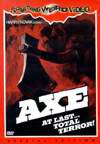Axe / The Child
Image Entertainment
Cast:
Extras: Bonus Feature, Trailers, Shorts, Drive-in Art, Radio Spots
Rating:
Our first feature, "Axe" is a depraved southern gothic, and is reminiscent of many other films. The movie opens with three hoods torturing and killing an associate and then humiliating a convenience store clerk. Fearful that the police will be hot on their trail, the trio, led by the evil Steele (Jack Canon) decide to ditch their car and hide out at a farm. The only inhabitants of the farm are young Lisa (Leslie Lee) and her invalid grandfather (Douglas Powers). Thinking that they’ve found the perfect hide-out, the three bully Lisa and threaten to kill her grandfather if she informs the police of their whereabouts. Little do know that the innocent looking Lisa doesn’t take kindly to threats and that the axe of the title is close at hand.
"Axe" is presented on this DVD in a full-frame ratio. The defects from the source print are the most noticeable flaw, as there are many scratches and dirt spots evident. There is also some distortion on the image. Occasionally, the picture will jump. There is a sharpness to the image, and the colors, though slightly washed out, look natural. The audio on this DVD is a <$DD,Dolby Digital> Mono, which should perfectly reproduce that one speaker hanging in the window, as at the drive-in. The dialogue is muffled at times, and there is some distortion from the musical score.
The second film in our double feature is called "The Child", and all I can say about this movie is that if it wasn’t made in Europe, it should have been. "The Child" comes across as a combination of "The Omen" and "Night of the Living Dead". Alicianne (Laurel Barnett) returns to her hometown (although we never see a town) to be a nanny for the Nordon family, specifically little Rosalie (Rosalie Cole). The Nordon’s have an odd reputation in the region and Rosalie is known for playing cruel practical jokes. There’s also the little matter of Rosalie’s tendency to go to the local cemetery and talk to zombies. Rosalie uses her undead friends to seek revenge on those whom she feels contributed to the untimely death of her mother. Alicianne finds herself thrown into this bizarre world and soon learns that her main task isn’t to look after Rosalie, it’s to survive.
As with "Axe", "The Child" is presented full-frame, but has many more problems. The defects from the source print are evident in most every shot of this transfer. Ranging from simple grain to blue scratches, it’s obvious that the negative used was in bad shape. Beyond those major problems, the colors are good and there isn’t much distortion on the screen. The Dolby Digital Mono soundtrack has to be one of the oddest ever, as the entire film appears to have been dubbed. Therefore, the dialogue is much louder than the sound effects. Also, some crazy one-track recording method must have been used, as dialogue and sound effects appear independently, but never together.
Along with the bonus movies, each DVD has extra educational shorts, which are tied into the main theme of the feature film. The "Axe" DVD has a short from 1952 entitled "Mental Health: Keeping Mentally Fit", which explores such controversial topics such as talking about your problems with someone you trust. The second short on this DVD focuses on sword swallowing. The real gems show on "The Child" DVD. First, we have "The ABC of Baby Sitting" (That’s not a typo. I guess it was considered radical to put an "s" on ABC back in the fifties. This film is an absolute hoot, as shows that paranoia is an absolute must for babysitters. "Don’t hesitate to call the police!" This film would have made a great extra on the "Halloween" DVD. The other short film presented here is called "The Outsider", which focuses on a girl who just doesn’t fit in. Maybe it’s because her name is Susan Jane. What kind of name is that?
Finally, each DVD is topped off with nine trailers for drive-in movies, including two for "Axe" under some of its alternative titles. Then, we are treated to a five-minute show reel which offers exploitation film art accompanied by radio spots for obscure films. (The one for "Last House on the Left" is particularly good.)







